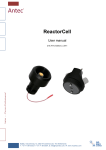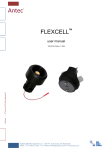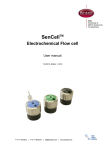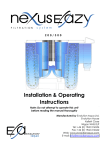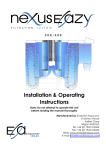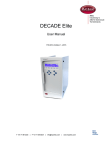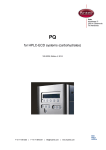Download SynthesisCell™ user manual
Transcript
Antec BV Industrieweg 12 2382 NV Zoeterwoude The Netherlands TM SynthesisCell User manual 206.0010, Edition 1, 2014 T +31 71 5813333 | F +31 71 5813334 | [email protected] | www.myantec.com Copyright ©2014, Antec, The Netherlands. Contents of this publication may not be reproduced in any form or by any means (including electronic storage and retrieval or translation into a foreign language) without prior agreement and written consent from the copyright of the owner. The information contained in this document is subject to change without notice. ROXY, ALEXYS, DECADE, DECADE II, INTRO, Flexcell, ReactorCell, SenCell, VT-03, SynthesisCell, SynthesisCell, ISAAC, HyREF are trademarks of Antec. Whatman™ (word and device) and Whatrnan™ (word only) are trademarks of Whatman lnternational Ltd. SOLVENT IFD™ and AQUEOUS IFD™ are trademarks of Arbor Technologies, Inc. Clarity®, DataApex® are trademarks of DataApex Ltd. Microsoft® and Windows™ are trademarks of Microsoft Corporation. Excel is a registered trademark of the Microsoft Corporation. The software and the information provided herein is believed to be reliable. Antec shall not be liable for errors contained herein or for incidental or consequential damages in connection with the furnishing, performance, or use of software or this manual. All use of the software shall be entirely at the user’s own risk. INTRODUCTION Table of contents 3 Intended use For research purposes only. While clinical applications may be shown, this instrument is not tested by the manufacturer to comply with the In Vitro Diagnostics Directive. WEEE directive Antec Leyden is a Business-to-Business producer of analytical analysis equipment which fall under WEEE Annex IA categories 8 and 9 (includes medical devices and monitoring and control instruments). All equipment of Antec Leyden which are subjected to the WEEE directive (shipped after August 13, 2005) are labelled with the “crossed out wheelie bin”. The symbol on the product indicates that the product must not be disposed as unsorted municipality waste. Collection & recycling information (business-to-business) Antec Leyden offers the possibility for disposal and recycling of their instrument at an appropriate recycling facility if requested (there may be costs involved with this service). Please contact Antec Leyden for more information about this service and to register the return and disposal of endof-life instruments ([email protected]). To assure hygienic & personal safety all instrument must be returned with a signed decontamination form which is available on the website. Shipping address for end-of-life products: Antec Leyden Industrieweg 12 2382NV Zoeterwoude, The Netherlands ROHS directive Our instruments are currently exempt from the RoHS directive because they fall under WEEE Annex IA categories 8 and 9, which includes medical devices and monitoring and control instruments. Nevertheless, we have taken steps to eliminate all restricted substances from our products. Antec Leyden is an ISO 9001:2008 certified company. 4 SynthesisCell™ user manual Symbols The following pictograms are used in this user manual: Warning/caution sign. It calls attention to a procedure or practice which, if not adhered to, could result in severe injury or damage to parts or all of the equipment. Do not proceed beyond a warning sign until the indicated conditions are fully understood and met. The attention sign signals relevant information. Read this information, as it might be helpful. The note sign signals additional information. It provides advice or a suggestion that may support you in using the equipment. INTRODUCTION Table of contents 5 Safety practices Perform periodic leak checks on LC tubing and cell connections. Do not allow flammable and/or toxic solvents to accumulate. Follow a regulated, approved waste disposal program. Never dispose of such products through the municipal sewage system. LC equipment should be used by trained laboratory personnel only. Use proper eye and skin protection when working with solvents. Additional safety requirements or protection may be necessary depending on the chemicals used in combination with this equipment. Make sure that you understand the hazards associated with the chemicals used and take appropriate measures with regards to safety and protection. Use of this product outside the scope of this guide may present a hazard and can lead to personal injury. Spare parts and service availability Manufacturer provides operational spare parts of the instrument and current accessories for a period of five years after shipment of the final production run of the instrument. Spare parts will be available after this five years period on an ‘as available’ basis. Manufacturer provides a variety of services to support her customers after warranty expiration. Repair service can be provided on a time and material basis. Contact your local supplier for servicing. Technical support and training can be provided by qualified chemists on both contractual and as-needed basis. 6 SynthesisCell™ user manual Table of contents Safety practices 5 Spare parts and service availability 5 Table of contents 6 The SynthesisCell 7 Introduction 7 References 9 Three-electrode configuration 10 HyREF reference electrode 10 HyREF versus Ag/AgCl Reference electrode 11 Example 11 Working electrodes 11 Installation 13 Unpacking 13 Preparations 14 Assembling the SynthesisCell 14 Operation 15 Maintenance 16 Working electrode maintenance 16 Decreased cell performance 16 Disassembly of the SynthesisCell 16 Maintenance Magic Diamond electrode 17 Activation of the electrodes using pulse mode 17 Activation of the electrodes using scan mode in acidic conditions 19 Storage 21 Specifications SynthesisCell 22 Accessories SynthesisCell 23 Ordering Information SynthesisCell 23 7 C H A P T E R 1 The SynthesisCell Introduction Congratulations on your purchase of the SynthesisCell. The SynthesisCell is a bulk electrochemical cell, designed for small-scale electrosynthesis of metabolites, reactive intermediates and other oxidation and reduction products in milligram quantities. The SynthesisCell is available with different working electrodes (WE): Tubular Reticulated Glassy Carbon (RGC), , Flat Smooth Magic Diamond (MD) and Tubular Mesh Platinum (Pt). Moreover, there are two types of reference electrodes the Pd/H2 (HyREF) and a salt bridge Ag/AgCl electrode (SB REF). A coiled platinum wire is used as an auxiliary electrode (AUX). For successful and efficient conversion, the parameters as the potential, composition of the solution (supporting electrolyte, organic solvent concentration, pH), need to be optimized depending on the type of compounds or desired reaction. In general, the samples can be oxidized in the solutions containing supporting electrolyte at concentrations of 10mM or higher. The higher concentration of supporting electrolyte, ca. 100mM, can improve conversion. In case MS is used for analysis, the solvent also affects the ESI response (ionization suppression). In that case the solvent must be compatible with ESI MS and to fulfill this requirement ammonium acetate, ammonium formate, formic acid or acetic acid can be used. It is not recommended to use acetic acid and its derivatives with Magic Diamond electrode. The information how to acquire the MS Voltammogram and use the Scan or DC mode for metabolite synthesis are described in the ROXY Potentiostat User manual (210.7010) and Dialogue for ROXY user guide (210.7017). Table 1. Typical enzymatic CYP reactions that can be done electrochemically. Compound indicated with asterisk is drawn as an example. Table is adapted from Lohmann et al. 2010. The electrochemical oxidation reactions are among others: S-oxidation, N-dealkylation, hydroxylation and dehydrogenation. 8 SynthesisCell™ user manual 9 Table 2. Examples of solvents used for electrochemical oxidation. Compound Mobile phase Electrode Acetaminophen 20mM ammonium acetate in 25% methanol 20mM ammonium formate (pH 7.4 adjusted with ammonium hydroxide) in 50% acetonitrile 50% methanol and 50% 10 mM aqueous formic acid 20mM ammonium formate with 0.1% formic acid (pH 3.3) in 50% acetonitrile Glassy Carbon, Magic Diamond Glassy Carbon, Magic Diamond Amodiaquine (1) Amodiaquine (2) Irinotecan Angiotensin Adenosine Tetrazepam Toremifene LYL, LWL (peptides) 0.1% formic acid in 50% acetonitrile 20mM ammonium formate (pH 7.3 adjusted with ammonium hydroxide) in 50% acetonitrile 10mM formic acid (pH 3.1) Glassy Carbon Glassy Carbon, Magic Diamond (on both different oxidation profiles were obtained) Magic Diamond Magic Diamond Platinum 20mM ammonium formate (pH Glassy Carbon 7.4 adjusted with ammonium hydroxide) in 50% methanol 90/10/1 (v/v/v) Glassy Carbon water/acetonitrile/formic acid References 1. A. Baumann et al., J. Chromatogr. A, 121 6, 3192–3198 (2009). 2. T. Johansson, L. Weidolf and U. Jurva, Rapid Commun. Mass Spectrom., 21, 2323–2331 (2007). 3. S.M. van Leeuwen et al., Anal. Bioanal. Chem., 382, 742–750 (2005). 4. W. Lohmann and U. Karst, Anal. Chem., 79, 6831–6839 (2007). 5. K.G. Madsen et al., Chem. Res. Toxicol., 21, 1107–1119 (2008). 6. S.M. van Leeuwen, H. Hayen and U. Karst, Anal. Bioanal. Chem., 378, 917–925 (2004). 7. B. Blankert et al., Electroanalysis, 17, 1501–1510 (2005). 8. W. Lohmann and U. Karst, Anal. Bioanal. Chem., 386, 1701–1708 (2006). 10 SynthesisCell™ user manual Three-electrode configuration In the SynthesisCell a three-electrode configuration is used (Error! Reference source not found.). The working potential is set between the working electrode and the auxiliary electrode (AUX). The auxiliary electrode is kept at a precisely defined reference electrode potential by means of the so-called voltage clamp. This is an electronic feedback circuit that compensates for polarisation effects at the electrodes. At the working electrode, which is kept at virtual ground, the electrochemical reaction takes place, i.e. electrons are transferred at the working electrode. This results in an electrical current to the I/E converter, which is a special type of operational amplifier. The output voltage can be measured by an integrator or recorder. Essentially, for the oxidation or reduction reaction it would be sufficient to use only two electrodes. However, the three-electrode configuration has several advantages over a two-electrode configuration. If the working potential would be applied only over an auxiliary electrode versus the working electrode (without reference electrode), the working potential would continuously change due to polarisation effects at the electrodes, resulting in highly unstable working conditions. If the working potential would be applied only over the reference electrode versus the working electrode (without auxiliary electrode), the working potential would be very well defined. However, the potential of a reference electrode is only well defined if the current drawn is extremely low (pico-amperes) which woud make this configuration useless for our purpose. A three-electrode configuration combines the best of both configurations. The reference electrode stabilises the working potential and the auxiliary electrode can supply high currents. This results in the tremendous dynamic range of a threeelectrode system, with sufficient yield in electrosynthesis. HyREF reference electrode The SynthesisCell is standard equipped with a HyREF (Pd/H2) reference electrode. The HyREF can be used under harsh conditions and is free of maintenance under normal use. An important characteristic of the HyREF is the pH dependence of the reference potential. It is important to realise that if the pH of the solvent is changed, also the optimum conversion potential changes. In such case it is advisable to redetermine the optimum potential by creating a voltammogram. 11 HyREF versus Ag/AgCl Reference electrode The reference potential of an Ag/AgCl and HyREF are different (Fig. 1). Lineaire regressie (W=1) pH 3.3 6.2 7.5 11.8 E (V) 232 130 90 0 Fig. 1. Potential difference between HyREF and Ag/AgCl REF versus pH. So, if an Ag/AgCl REF is compared to a HyREF, the pH effect on HyREF, compared to Ag/AgCl must be taken into account. The pH-voltage relation is described by: EHyREF = EAg/AgCl - 328 + 29.9 pH (1) Example If an Ag/AgCl REF is exchanged for a HyREF a working potential of 800 mV (vs. Ag/AgCl) at pH 3, has to be changed to: EHyREF = 800 - 328 + 29.9*3 = 560 mV (vs. HyREF) As a rule of thumb, the working potential should be chosen such that a similar background signal (I-cell) is measured with the HyREF as in using the Ag/AgCl REF. Working electrodes Electrochemical conversion puts high demands on the working electrode material. The working electrode should be made of a (electro-)chemically inert material. Furthermore, to avoid an irregular flow profile over the electrode, it should have a very well defined surface. In the table I the working potential limits are listed of the WE materials available for SynthesisCell. The values presented in the table are 12 SynthesisCell™ user manual only the estimation and will depend on mobile phase composition (pH, supporting electrolyte) and the analyzed compound itself. At high positive working potentials the water in the mobile phase electrolyses and results in decrease in metabolites formation. In case of electrolysis of the water/mobile phase the cell current (Icell) readout will display the message “overload” and auxiliary potential (Eaux) will have the extreme value (-9.9V). Furthermore, in case of EC/MS the electrospray signal will become very unstable because of gas formed in the cell and loss of the signal can be observed. When such a phenomenon is observed it is recommended to adjust the potential to a lower value. Table 3. Working potential limits for electrodes (WE) used with SynthesisCell. WE material potential limits vs. HyREF (V) Oxidation reduction Glassy carbon Magic diamond +2.5V +3.5V -1.5V -2.5V The MD electrode consisting of an ultra-thin film of doped diamond material deposited on a carrier. The special properties of doped diamond electrodes, such as a wide potential window, their inertness and excellent response stability, makes them well suited for electrochemical conversion of a wide variety electro-analytical application. The MD electrode is perfect choice if the oxidation of the analyte requires high potential in aqueous electrolytes. 13 C H A P T E R 2 Installation Unpacking Inspect the transport box for possible damage as it arrives. Immediately inform the transport company in case of damage, otherwise she may not accept any responsibility. Contact your supplier in case of damage or if not all marked items on the checklist are included. Prior to shipment, your SynthesisCell has been thoroughly inspected and tested to meet the highest possible demands. The results of all tests are included. Picture 1. SynthesisCell with RGC WE and HyREF. 1: WE contact, 2: AUX contact, 3: HyREF contact, 4: Additional port for gas purging or sampling, 5: SynthesisCell cap, 6: RGC WE , 7: Glass reaction vessel. This hardware should be used by trained laboratory personnel only. Use proper eye and skin protection when working with solvents. Additional safety requirements or protection may be necessary depending on the chemicals used in combination with this equipment. Make sure that you understand the hazards associated with the chemicals used and take appropriate measures with regards to safety and protection. The SynthesisCell is delivered pre-assembled however some protectors for safe transportation must be removed before use. 14 SynthesisCell™ user manual Never switch ON the flow cell when: - the cell cable is not correctly connected - the cell is not filled with buffer/electrolyte because substantial damage to the working electrode or electronics may occur. Preparations 1. Take the SynthesisCell from the shipping box and remove the protecting foam parts. 2. Prepare a solution containing the substance(s) and a supporting electrolyte (ammonium formate, formic acid, or acetic acid, 0.1 - 1% in water). 3. Download and install the latest version of Dialogue software: http://www.myantec.com/support/documents-and-downloads/downloadsoftware Picture 2. A: RGC WE fixed in the vessel cap. B: WE fixed in the glass reaction vessel. C: AUX in the fritted glass tube. D: AUX assembled in the vessel cap. Assembling the SynthesisCell 4. Fill the glass reaction vessel with a solution containing electrolyte(s) and substance(s). The maximum allowed volume is 80mL. Put the stirrer in the vessel. 5. Place the vessel cap on the WE and fix the WE position (height) with the retaining rings as indicated in the picture 2A. 6. Place the WE in the vessel (Picture 2B). Adjust the position of WE if needed by careful pushing or pulling the white Teflon contacts. The RGC 15 WE is fragile and must be handled with care. Keep the wires connecting the WE with the Teflon tubes dry. 7. Place the AUX electrode in the fritted glass tube (Picture 2C) and mount it in the vessel cap (Picture 2D). The AUX tube should be filled with mobile phase which takes a minute. The fritted glass tube keeps the AUX separated from the WE, reaction products on both electrodes are not mixed. An additional tube without frit is available for cases where the mixing of products is allowed. 8. Place the HyREF in the vessel cap (Picture 2D). Operation 9. Place the SynthesisCell on the magnetic stirrer and adjust the rotation. 10. Connect the cell cable as shown in the picture 4. Red: WE, blue: AUX and black: REF. 11. Set the measurement conditions using Dialogue. The user manual (210.7017 – Dialogue for ROXY) is available on our website. 12. The reaction is started as soon as the SynthesisCell is started. Depending on the substance(s) and the applied potential, the cell current (I-Cell) can go up to 2 – 20 mA. 13. Monitor the formation of product by taking aliquots from the vial through the sampling port. 14. A 0.1 mmol/L (1.5 mg) MOPEG solution is for 90% converted in about 40 min under optimized conditions. 15. When finished, switch off the cell and collect the solution in another vial. When mixing of electrode solutions is not allowed, first take out the AUX without mixing. 16 SynthesisCell™ user manual C H A P T E R 3 Maintenance Working electrode maintenance Activation of the working electrode is necessary if the electrode surface has been electrochemically changed. This may be due to fouling by oxidation (reduction) reaction products. Excessively high currents also may change the electrode surface. This is noticed by a strongly decreased sensitivity after prolonged use. Decreased cell performance Several actions can be taken at decreased flow cell performance. Take the next step only if the previous was not successful. 1. Rinse the electrodes with clean solvent (water with ca 50% organic solvent). Clean (wipe) the REF and AUX with a wetted tissue with solvent. 2. Electrochemical activation of the GC and MD electrodes using pulse mode (see separate section of this manual). 3. The (re)activation procedure for Diamond electrodes using scan mode (see separate section of this manual). Disassembly of the SynthesisCell If the working electrode needs maintenance, the cell has to be disassembled. Before disassembling the flow cell read General precautions. 1. Switch off the cell and disconnect the cell cable. 2. Remove the AUX and the HyREF. 3. To remove the WE. Gently push the WE downwards using the white Teflon contacts, than pull it up to remove the retaining rings. Gently rest the WE on the bottom of the cell. Remove the vessel cap, and remove WE from the vessel. Use proper eye and skin protection when working with solvents. 17 Maintenance Magic Diamond electrode The Magic Diamond working electrode consists of an ultra-thin crystalline Diamond layer deposited on a carrier metal. Therefore, such electrode cannot be polished to restore the electrode surface in case of contamination. An effective method to restore the performance is by electrochemical reactivation of the electrode surface under acidic conditions. Activation of the electrodes using pulse mode This activation procedure is suitable for both MD and GC electrodes. 1. Refill the bottle with clean solvent containing the supporting electrolyte, e.g., the same solvent used for oxidation of the sample. 2. Go to the Options pull down menu and choose “Detection mode” (Fig. 17). Fig. 2. Pull down menu: Options Detection Mode. 3. Select Pulse mode (Fig.18) and click OK. Fig. 3. Select mode window. 4. Set the parameters in the cell control window (Fig. 19). 18 SynthesisCell™ user manual Parameter E1 E2 E3 t1 t2 t3 Ts Value +2V -2V 0V 1000 ms 1000 ms 0 ms 20 ms (It is recommended to set the Output Range to 200 µA.) 5. Set Run time value to 5 min and turn on the cell. 6. Go to Options pull down menu and click Start Run (Fig. 20). Program will ask to save the data (The excel file will be created). And start the acquisition. Fig. 4. The cell settings in the pulse mode for MD electrode activation. Fig. 5. Start the activation procedure. 19 After the activation procedure turn OFF the cell and leave the flow for additional 12min. The activation procedure is available also as a program (Activation_pulse_rev01.evt) and can be executed automatically via events window (Fig. 22). The method can be found in My Documents and in the subfolders: Dialogue\Templates. The detailed background information about the supplied events files and relevant Dialogue settings are provided in the Dialogue for ROXY User guide (210.7017). Fig. 6. Activation procedure event table. The syringe pump commands are ignored as no pump is connected. In case that no significant improvement of the cell performance is seen: A. For MD electrode use the electrochemically reactivation of the electrode surface under acidic conditions. B. For RGC electrode, replace the electrode for a new one. Activation of the electrodes using scan mode in acidic conditions 1. Disassemble the SynthesisCell as described on page 12. Keep the MD electrode disc fixed inside the working electrode assembly. 2. Wipe the electrode surface with a tissue wetted with methanol or acetone and subsequently with demi water to clean the electrode surface. Wear gloves: Under all circumstances try to avoid direct contact of the electrode surface with fingers. The skin contains fatty substances which will foul the electrode. 20 SynthesisCell™ user manual 3. Assemble the SynthesisCell with MD electrode as described in the previous section. 4. Prepare a solvent of 0.5 M Nitric acid (HNO3), fill and install the SynthesisCell. Make sure that all parts that are not acid-resistant are not connected in the system during this step. 5. Set the ROXY in SCAN mode with the following settings: E1 = -3.00 Volt, E2 = +3 Volt, Scan rate: 50 mV/s, scan cycle: continuous and range 200 µA/V. 6. Start scanning under acidic conditions for 1 hours. 7. After scanning switch off the cell and the flow rate, replace the solvent by HPLC grade water and flush (wash) the cell to remove the acidic solution. 8. You can start up the synthesis again. In the case there is no significant sensitivity improvement observed, repeat step 1 to 10 and increase the total scan time (step 7). One can also try to perform the activation procedure under the mobile phase conditions of the application. Furthermore, in literature anodic treatments are reported (for example the application of a static potential of + 3 Volt vs. Ag/AgCl for 5 – 10 minutes) to restore the electrode response. Such procedure could be executed as an alternative, if the above-mentioned procedure does not lead to satisfactory results. Electrochemical reactivation procedure for MD electrode is part of the ROXY firmware and available via display panel (DiagActivate). The scan settings and the duration are as described in points 6 and 7, and only “push button” action is needed to execute it (See ROXY Potentiostat user manual (210.7010)). Replace the Magic Diamond electrode disc when no improvement is seen after repeated reactivation/conditioning attempts. Chemical compatibility: The MD electrode exhibits an excellent inertness and can be used with a large variety of mobile phase and chemicals. However it has been observed that the MD electrode operational lifetime is strongly reduced when exposed to fluorinated acids, such as tri-fluoroacetic acid. Even at relatively low concentrations (2% in aqueous solution) significant damage of the diamond electrode was seen within days of operation (delamination/’blister’ formation of the MD layer). 21 Storage If the cell is not in use, switch off the cell, wash and store with water. If not in use for longer time (several days, weeks), wash all parts with water and store clean and dry. Before disconnecting the cell from the detector, turn off the cell first ! 22 SynthesisCell™ user manual C H A P T E R 4 Specifications SynthesisCell Cell type Three electrode synthesis cell, consisting of working electrode (WE), reference electrode (RE) and auxiliary electrode (AUX) Cell volume Up to 80 mL of sample solution in glass reaction vessel Optional: Water-jacketed reaction vessel (for cooling exothermic reactions) Working electrodes (WE) Tubular Reticulated Glassy Carbon (RGC) Optional: Flat Smooth Magic Diamond (MD) Tubular Mesh Platinum (PT) Reference electrode (RE) Pd/H2 reference electrode, HyREF Optional: Ag/AgCl reference electrode Auxiliary electrode (AUX) Coiled platinum wire in glass isolation tube Port plug Access port for sample collection, dispensing of reagents, or venting of cell Electric connections Cell cables for use with ROXY Potentiostat 23 C H A P T E R 5 Accessories SynthesisCell The Antec SynthesisCell (p/n 206.4300) is shipped together with a number of parts listed below (in shipkit). Use these part numbers when re-ordering parts. Part no Description 206.0037 Complete SynthesisCell, consisting of 80 mL reaction vessel with Tefloncap, WE (Tubular Reticulated Glassy Carbon), RE (HyREF) and AUX electrodes, stir bar, electrode cables, etc., all parts included for immediate use with ROXY Potentiostat. Optional 206.0300 Water-jacketed reaction vessel 206.0306 Flat Smooth Magic Diamond (MD) working electrode 206.0322 Tubular Mesh Pt (PT) working electrode 206.0314 Ag/AgCl reference electrode Spare Parts 206.0304 Tubular Reticulated Glassy Carbon (RGC) working electrode 206.0310 Auxiliary Pt electrode in glass tube 206.0900 Glass reaction vessel, 80 mL 206.0340 Glass coated magnet stir bar, length 8mm























